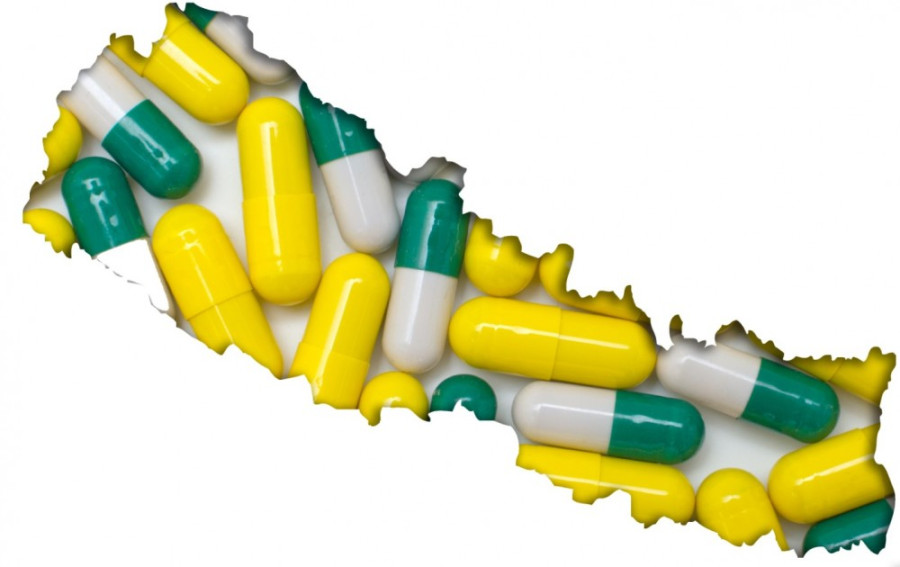Health
Antibiotic misuse triggering health crisis
Antimicrobial resistance genes were detected in 81 percent of samples tested in Nepal.
Arjun Poudel
Doctors prescribed antibiotics to a four-year-old boy after his mother complained of swelling and excessive redness at the injection point of her son after he had been inoculated with the rabies vaccine.
After the seven-day antibiotics course was completed, instead of getting cured, the boy could not move his left hand and complained of a burning sensation on his left side.
“Swelling had increased and spread to the lower parts of the arm,” complained Santoshi Acharya, the mother who is a local resident of Tarakeshwar-5 in Kathmandu. “We rushed our son to the Kanti Children's Hospital for treatment.”
Doctors at the hospital told the parents that the boy should undergo surgery to drain the pus accumulated in the vaccinated area, caused by an infection. After the surgery, another course of antibiotics was administered to the child, and the parents were asked to continue dressing the wound.
“But every time when we took our son for dressing, more pus mixed with blood would be discharged from the wound,” said Acharya. “We rushed to the hospital two days before the follow-up date to learn that the bacteria responsible for the infection had developed resistance to the antibiotics given to our son as well as to several other antibiotics.”
This is a common refrain among Nepali patients affected by antimicrobial resistance due to irrational use of several types of antibiotics for the treatment of infections. Antibiotics, which have saved millions of lives throughout the world, could soon become ineffective due to the high resistance rate caused by their irrational use, experts warned.
“We don’t have a system to record all cases of antimicrobial resistance and deaths from it, but what we can say is that the problem is huge,” said Dr Dibesh Karmacharya, chairman at the Center for Molecular Dynamics Nepal and Biovac Nepal. “Even the second and third line drugs have stopped working due to the irrational use of antibiotics.”
The World Health Organisation said antimicrobial resistance occurs when bacteria, viruses, fungi and parasites change over time and no longer respond to medicines, making infections harder to treat and increasing the risk of disease spread, severe illness and death. As a result, the medicines become ineffective and infections persist in the body, increasing the risk of spreading to others.
Even though antibiotics are prescription drugs, they can be easily purchased over the counter. Many people buy these drugs without telling the pharmacists their exact problem. Pharmacists too do not bother to inquire and in most cases fail to emphasise the importance of completing the course of medicine.
Doctors often prescribe antibiotics on the basis of clinical diagnosis, even before they get laboratory test reports. Experts say antibiotics do not work if the underlying infection is caused by a virus.
Doctors say sensitivity to the antibiotics must be known before the prescription, but very few doctors bother to understand their patient’s sensitivity to the drugs they prescribe. Patients also do not have knowledge that the course of antibiotics must be completed and if they stop halfway, the same antibiotic may not work the next time.
A 40-year-old man from Kathmandu had Scalp folliculitis, a skin condition where small sacs on the scalp are inflamed or irritated. The patient had itching, burning, sensation and sacs were filled with pus.
The man reached the hospital after the ailment could not be cured even after a full course of regular antibiotics.
“When the culture of pus was carried out, Staphylococcus pyogenes bacteria was found,” said Karmacharya. “And, what concerns us is that only one of the several regularly used antibiotics have been found to be effective against the pathogen.”
Doctors say it is a matter of grave concern that antibiotics, which are one of the most potent tools for the treatment of pathogen infection, are becoming ineffective.
In a study in humans, animals and environment samples, antimicrobial resistance genes were detected in 81 percent of total samples on which antimicrobial resistance tests were carried out.
“Sixty-nine out of 88 resistance genes were detected in 13 out of 16 antibiotic classification groups and in all but 12 samples (7 rodents, 5 water samples),'' reads the report published in the journal, Nature. “All seven genes prioritised for this analysis were detected in all sources sampled, with the exception of rodents.”
Swab samples of humans, chickens, ducks, and swine were collected for testing. Likewise water samples were also collected from households from Jadibuti, Kathmandu. Faecal samples of rodents and shrews were studied as well.
Moreover, antimicrobial resistance has emerged as a worldwide concern due to the acute health threat posed by antibiotic-resistant pathogens. While human antibiotic use contributes to antibiotic resistance, the widespread use of antibiotics in agricultural applications – most notably livestock and poultry production – is also a potential driver.
Doctors say agricultural antibiotic use leads to the presence of resistant bacteria in meat and poultry products; in addition, resistant organisms are released from farms into soil, groundwater, and surface waterways, leading to contamination of water sources for crop irrigation and domestic usage.
“Antimicrobial resistance showed up in 11 out of 16 antibiotic categories,” said Karmacharya. “The risk of running out of options is growing. The first-line and second-line antibiotics are not working in humans as well as animals, and even the third-line antibiotics are becoming completely ineffective.”
In 2019, there were an estimated 13·7 million infection-related deaths globally, with 7·7 million deaths associated with 33 bacterial pathogens.




 5.4°C Kathmandu
5.4°C Kathmandu













%20(1).jpg&w=300&height=200)
